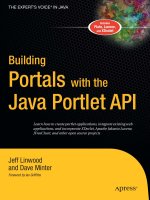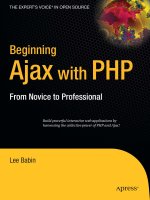Pattern Matching with egular Expressions R
Bạn đang xem bản rút gọn của tài liệu. Xem và tải ngay bản đầy đủ của tài liệu tại đây (176.4 KB, 15 trang )
Chapter 10. Pattern Matching with
egular Expressions
is an object that describes a pattern of characters. The JavaScript
Exp class represents regular expressions, and both String and RegExp define methods
t use regular expressions to perform powerful pattern-matching and search-and-
[1]
R
A regular expression
Reg
tha
replace functions on text.
[1]
The term "regular expression" is an obscure one that dates back many years. The syntax used to describe a textual pattern is indeed a type of
expression. However, as we'll see, that syntax is far from regular! A regular expression is sometimes called a "regexp" or even an "RE."
JavaScript regular expressions were standardized in ECMAScript v3. JavaScript 1.2
implements a subset of the regular expression features required by ECMAScript v3, and
JavaScript 1.5 implements the full standard. JavaScript regular expressions are strongly
based on the regular expression facilities of the Perl programming language. Roughly
speaking, we can say that JavaScript 1.2 implements Perl 4 regular expressions, and
JavaScript 1.5 implements a large subset of Perl 5 regular expressions.
This chapter begins by defining the syntax that regular expressions use to describe textual
patterns. Then it moves on to describe the String and RegExp methods that use regular
expressions.
10.1 Defining Regular Expressions
In JavaScript, regular expressions are represented by RegExp objects. RegExp objects
may be created with the RegExp( ) constructor, of course, but they are more often
created using a special literal syntax. Just as string literals are specified as characters
within quotation marks, regular expression literals are specified as characters within a
pair of slash (/) characters. Thus, your JavaScript code may contain lines like this:
var pattern = /s$/;
This line creates a new RegExp object and assigns it to the variable pattern. This
particular RegExp object matches any string that ends with the letter "s". (We'll talk
about the grammar for defining patterns shortly.) This regular expression could have
equivalently been defined with the RegExp( ) constructor like this:
var pattern = new RegExp("s$");
Creating a RegExp object, either literally or with the RegExp( ) constructor, is the easy
part. The more difficult task is describing the desired pattern of characters using regular
expression syntax. JavaScript adopts a fairly complete subset of the regular expression
syntax used by Perl, so if you are an experienced Perl programmer, you already know
how to describe patterns in JavaScript.
Regular expression pattern specifications consist of a series of characters. Most
characters, including all alphanumeric characters, simply describe characters to be
matched literally. Thus, the regular expression /java/ matches any string that contains
the substring "java". Other characters in regular expressions are not matched literally, but
have special significance. For example, the regular expression /s$/ contains two
characters. The first, "s", matches itself literally. The second, "$", is a special
metacharacter that matches the end of a string. Thus, this regular expression matches any
string that contains the letter "s" as its last character.
The following sections describe the various characters and metacharacters used in
JavaScript regular expressions. Note, however, that a complete tutorial on regular
expression grammar is beyond the scope of this book. For complete details of the syntax,
consult a book on Perl, such as
Programming Perl, by Larry Wall, Tom Christiansen, and
Jon Orwant (O'Reilly). Mastering Regular Expressions, by Jeffrey E.F. Friedl (O'Reilly),
is another excel
ral Characters
ve see selves literally in regular
ons. ports certain nonalphabetic
characters through escape sequences that begin with a backslash (
\). For example, the
sequence \n matches a literal newline character in a string. Table 10
lent source of information on regular expressions.
10.1.1 Lite
As we' n, all alphabetic characters and digits match them
expressi JavaScript regular expression syntax also sup
-1 lists these
characters.
Table 10-1. Regular expression literal characters
Character Matches
Alphanumeric
character
Itself
\0
The NUL character (\u0000)
\t
Tab )(\u0009
\n
Newline (\u000A)
\v
Vertical tab (\u000B)
\f
Form feed (\u000C)
\r
Carriage return (\u000D)
\xnn
The Latin character specified by the hexadecimal number nn; for
Table 10-1. Regular expression literal characters
Character Matches
example, \x0A is the same as \n
\uxxxx
The Unicode character specified by the hexadecimal number xxxx;
for example, \u0009 is the same as \t
\cX
The control character ^X; for example, \cJ is equivalent to the
newline character \n
A number of punctuation characters have special meanings in regular expressions. They
are:
^ $ . * + ? = ! : | \ / ( ) [ ] { }
ny of these punctuation characters literally in a regular expression, you must precede
em with a \. Other punctuation characters, such as quotation marks and @, do not have
special meaning and simply m
emember exactly which punctuati ers need to be escaped with a
ou may safely place a backslash befo aracter. On the
other hand, note that many letters and numbers have special meaning when preceded by a
lash, so any letters or numbers that you want to match literally should not be
ed with a backslash. To include a backslash character literally in a regular
ession, you must escape it with a backslash, of course. For example, the following
regular expression matches any string that includes a backslash:
/\\/.
10.1.2 Character Classes
rs can be combined into character classes by placing them
ithin square brackets. A character class matches any one character that is contained
within it. Thus, the regular expression
/[abc]/ matches any one of the letters a, b, or c.
Negated character classes can also be defined -- these match any character except those
contained within the brackets. A negated character class is specified by placing a caret (^)
as the first character inside the left bracket. The regexp /[^abc]/ matches any one
character other than a, b, or c. Character classes can use a hyphen to indicate a range of
characters. To match any one lowercase character from the Latin alphabet, use /[a-z]/,
and to match any letter or digit from the Latin alphabet, use
/[a-zA-Z0-9]/.
We'll learn the meanings of these characters in the sections that follow. Some of these
characters have special meaning only within certain contexts of a regular expression and
are treated literally in other contexts. As a general rule, however, if you want to include
a
th
atch themselves literally in a regular expression.
If you can't r
backslash, y
on charact
re any punctuation ch
backs
escap
expr
Individual literal characte
w
Because certain character classes are commonly used, the JavaScript regular expression
syntax includes special characters and escape sequences to represent these common
classes. For example, \s matches the space character, the tab character, and any other
Unicode whitespace character, and \S matches any character that is not Unicode
whitespace. Table 10-2 lists these characters and summarizes character class syntax.
(Note that several of these character class escape sequences match only ASCII characters
and have not been extended to work with Unicode characters. You can explicitly define
your own Unicode character classes; for example, /[\u0400-04FF]/ matches any one
Cyrillic character.)
Table 10-2. Regular expression character classes
Character Matches
[...]
Any one character between the brackets.
[^...]
Any one character not between the brackets.
.
Any character except newline or another Unicode line terminator.
\w
Any ASCII word character. Equivalent to [a-zA-Z0-9_].
\W
Any character that is not an ASCII word character. Equivalent to [^a-zA-
Z0-9_].
\s
Any Unicode whitespace character.
\S
Any character that is not Unicode whitespace. Note that \w and \S are not
the same thing.
\d
Any ASCII digit. Equivalent to [0-9].
\D
Any character other than an ASCII digit. Equivalent to [^0-9].
[\b]
A literal backspace (special case).
Note that the special character class escapes can be used within square brackets. \s
matches any whitespace character and \d matches any digit, so /[\s\d]/ matches any
one whitespace character or digit. Note that there is one special case. As we'll see later,
the \b escape has a special meaning. When used within a character class, however, it
represents the backspace character. Thus, to represent a backspace character literally in a
regular expression, use the character class with one element: /[\b]/.
10.1.3 Repetition
With the regular expression syntax we have learned so far, we can describe a two-digit
number as
/\d\d/ and a four-digit number as /\d\d\d\d/. But we don't have any way to
describe, for example, a number that can have any number of digits or a string of three
letters followed by an optional digit. These more complex patterns use regular expression
syntax that specifies how many times an element of a regular expression may be
repeated.
The characters that specify repetition always follow the pattern to which they are being
applied. Because certain types of repetition are quite commonly used, there are special
characters to represent these cases. For example, + matches one or more occurrences of
the previous pattern. Table 10-3 summarizes the repetition syntax. The following lines
show some examples:
/\d{2,4}/ // Match between two and four digits
/\w{3}\d?/ // Match exactly three word characters and an optional
digit
/\s+java\s+/ // Match "java" with one or more spaces before and after
/[^"]*/ // Match zero or more non-quote characters
Table 10-3. Regular expression repetition characters
Character Meaning
{n,m}
Match the previous item at least n times but no more than m times.
{n,}
Match the previous item n or more times.
{n}
Match exactly n occurrences of the previous item.
?
Match zero or one occurrences of the previous item. That is, the previous
item is optional. Equivalent to {0,1}.
+
Match one or more occurrences of the previous item. Equivalent to {1,}.
*
Match zero or more occurrences of the previous item. Equivalent to {0,}.
Be careful when using the * and ? repetition characters. Since these characters may
match zero instances of whatever precedes them, they are allowed to match nothing. For
example, the regular expression
/a*/ actually matches the string "bbbb", because the
string contains zero occurrences of the letter a!
repetition
The repetition characters listed in
Table 10-3
10.1.3.1 Non-greedy
match as many times as possible while still
allowing any following parts of the regular expression to match. We say that the
repetition is "greedy." It is also possible (in JavaScript 1.5 and later -- this is one of the
Perl 5 features not implemented in JavaScript 1.2) to specify that repetition should be
done in a non-greedy way. Simply follow the repetition character or characters with a
question mark:
??, +?, *?, or even {1,5}?. For example, the regular expression /a+/
matches one or more occurrences of the letter a. When applied to the string "aaa", it
matches all three letters. But /a+?/ matches one or more occurrences of the letter a,
matching as few characters as necessary. When applied to the same string, this pattern
matches only the first letter a.
Using non-greedy repetition may not always produce the results you expect. Consider the
pattern /a*b/, which matches zero or more letters a followed by the letter b. When
applied to the string "aaab", it matches the entire string. Now let's use the non-greedy
version: /a*?b/. This should match the letter b preceded by the fewest number of a's
possible. When applied to the same string "aaab", you might expect it to match only the
last letter b. In fact, however, this pattern matches the entire string as well, just like the
greedy version of the pattern. This is because regular expression pattern matching is done
by finding the first position in the string at which a match is possible. The non-greedy
vers
returned; matches at subsequent chara even considered.
ernation, Grouping, and R es
e regular ar includes special characters for specifying alternatives,
grouping subexpressions, and referring to previous subexpressions. The | character
es alternatives. For example, /ab|cd|ef/ matches the string "ab" or the string
the string "ef". And /\d{3}|[a-z]{4}/ matches either three digits or four
lowercase letters.
alt t until a match is found. If the left
alternative matches, the right alternative is ignored, even if it would have produced a
"better" match. Thus, when the pattern /a|ab/ is applied to the string "ab", it matches
y the first letter.
Parentheses have several purposes in regular expressions. One purpose is to group
parate items into a single subexpression, so that the items can be treated as a single unit
by |, *, +, ?, and so on. For example, /java(script)?/ matches "java" followed by the
optional "script". And /(ab|cd)+|ef)/ matches either the string "ef" or one or more
repetitions of either of the strings "ab" or "cd".
Another purpose of parentheses in regular expressions is to define subpatterns within the
complete pattern. When a regular expression is successfully matched against a target
string, it is possible to extract the portions of the target string that matched any particular
parenthesized subpattern. (We'll see how these matching substrings are obtained later in
the chapter.) For example, suppose we are looking for one or more lowercase letters
followed by one or more digits. We might use the pattern
/[a-z]+\d+/. But suppose we
only really care about the digits at the end of each match. If we put that part of the pattern
in parentheses (/[a-z]+(\d+)/), we can extract the digits from any matches we find, as
explained later.
A related use of parenthesized subexpressions is to allow us to refer back to a
subexpression later in the same regular expression. This is done by following a
\
character by a digit or digits. The digits refer to the position of the parenthesized
ion of our pattern does match at the first character of the string, so this match is
cters are never
10.1.4 Alt eferenc
Th expression gramm
separat
"cd" or
Note that ernatives are considered left to righ
onl
se









